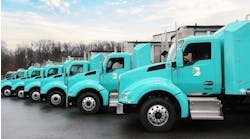Fueling with natural gas is relatively easy, but different from gasoline or diesel. Latch a special fitting at the end of the CNG fuel hose to the fueling nipple on the CNG fuel tank and then turn on the dispenser to transfer CNG into the vehicle’s tanks.
With a liquid fuel like gasoline or diesel, the fueling stops abruptly when the vehicle’s tank is full and the fuel has backed up into the filler, shutting off the flow from the pump. With natural gas, there is no abrupt stop. Rather, the fueling just slows down as the tank fills.
When the pump determines the tank has reached maximum pressure, the pump will stop and the readout on the pump will indicate “100 percent.” Then, unlatch the fitting from the fueling nipple and return the hose back to the dispenser.
GALLON EQUIVALENTS
The CNG dispenser displays the pressure at which the tank is being filled and calculates and shows how many gasoline gallon equivalents (GGEs) are delivered into the vehicle. To determine the diesel gallon equivalents (DGEs) received, multiply the GGEs by 1.13 – the DGE quantity.
This is necessary as energy content is different in a gallon of gasoline than it is in a gallon of diesel.
PROPERTIES
There is no need to be alarmed by the hissing sound when the hose is disconnected. This occurs because CNG for vehicle fueling is pressurized at 3,600 psi.
Natural gas is delivered by a pipeline to a fueling station. There, the gas is compressed, dried and stored at 4,500 psi. It is dispensed into a vehicle at 3,600 psi.
The faster you fuel with CNG, the more heat the gas gains. As the fuel warms up it becomes less dense and, therefore, contains less energy by volume when the fuel system reaches the rated pressure.
For this reason, you are usually able to get more CNG into a tank with a time-fill versus a fast-fill application. With time-fill, the fuel is slowly dispensed over time so that the heat of compression is lower, allowing a fuller fill than with fast-fill.
SAFETY
No special safety equipment is required for CNG fueling. Compressed natural gas is non-corrosive and non-toxic. There are no poisonous ingredients in it that can be absorbed into the blood if inhaled and few associated health risks. There is no potential for ground or water contamination in the event of a fuel release.
Compressed natural gas is lighter than air. If there ever was a leak in a CNG fuel system, the gas would simply disperse into the atmosphere, significantly lowering the risk of ignition.
What’s more, natural gas has an ignition temperature of 1,100 degrees F, meaning it takes a higher temperature to ignite natural gas compared to gasoline or diesel.



